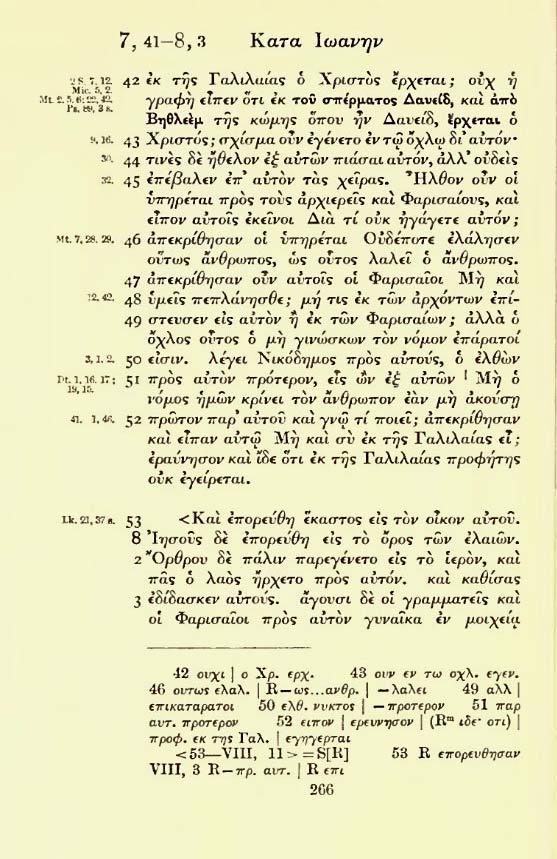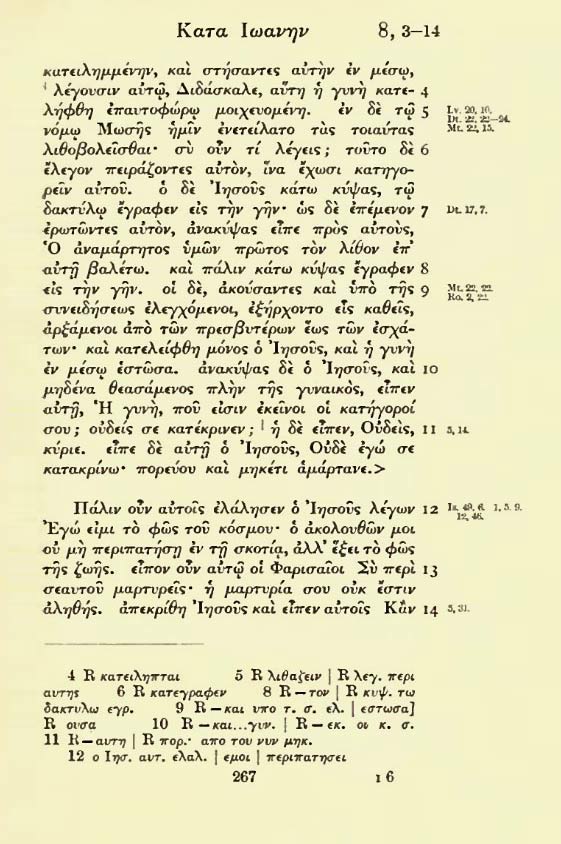INTRODUCTION
Background

Eberhard Nestle (1851 – 1913) was a German scholar and father of Erwin Nestle. He published an influential handbook of textual criticism, and in 1898 published the first edition of Novum Testamentum Graece, a Greek New Testament combining the editions of Constantin von Tischendorf, Westcott and Hort, and Richard Francis Weymouth. This edition became influential when the British and Foreign Bible Society adopted it to replace the Textus Receptus.
- Wikipedia
The Nestle Critical Greek NT
NESTLE'S GREEK TEXT. Eberhard Nestle’s Greek text, which first appeared in 1895, was based on Tischendorf’s 8th edition of 1869-72, Westcott and Hort’s edition of 1881, and the 1902 edition of D. Bernhard Weiss (TBS Article No. 56). Tischendorf stayed closely to the Codex Sinaiticus, while Westcott and Hort largely followed the Vaticanus.
Thus the Nestle Text is founded largely upon the Vaticanus and Sinaiticus manuscripts.
The Nestlé’s Text has gone through 27 editions and has been widely used in Bible College and seminary classrooms and translation work. Aberhard’s son Erwin Nestle succeeded to the editorship of the Nestle Text after Aberhard’s death in 1913. In 1950 Kurt Aland became associated with the Nestle project and later editions of the Nestlé Text are called the Nestlé-Aland Text.
...
The fathers of modern textual criticism in the 19th century were, for the most part, theological modernists and Unitarians or were men who were sympathetic to this position. Since the 20th century, even a greater degree of skepticism has dominated this field. For example, all of the editors of the United Bible Societies Greek NT (the UBS text) reject the doctrine of verbal inspiration and believe that the Bible is filled with myths.
The following are some of the chief names in this field of the past century, and to a man they rejected verbal inspiration:
Philip Schaff, Joseph Thayer, Eberhard Nestle, Hermann von Soden, Frederic Kenyon, Kirsopp Lake, C.H. Dodd, Ernest Colwell, Kenneth Clark, Francis Burkitt, Frederick Conybeare, Rudolf and Gerhard Kittel, Henry Clay Vedder, James Rendel Harris, Adolf von Harnack, Caspar Gregory, Francis Brown, Samuel Rolles Driver, Charles Briggs, Alexander Souter, Henry Wheeler Robinson, James Moffatt, John Goodspeed, Millar Burrows, Theodore Skeat, William Barclay, J.B. Phillips, Gunther Zuntz, George Kilpatrick, F.F. Bruce, Reginald Fuller, Robert Grant, George Ladd, Bart Ehrman, Brevard Childs, Eldon J. Epp, J.K. Elliott, Kurt Aland, Matthew Black, Allen Wikgren, and Bruce Metzger.
Nestle's Shameless Promotion of his NT
On the dubious behaviour of Eberhard Nestle regarding the promotion of his own critical Greek text, we have the following information posted by James Snapp Jr. on TC-Alt:
"Novum Testamentum Graece [the Nestle Critical Greek NT text] was not always as widely accepted as it is today. That's due to a lot of factors, and this post will not describe all of them. Here, I want to just focus on one of them -- a factor that is not as large as others, but which may have helped tip the scales in favor of Nestle's text early in its history.
In the late 1800's and early 1900's, debate about the critical text which was the basis of the Revised Version was fairly intense. Doubts about the Alexandrian Text -- was it a recension?? -- and reservations about Hort's theories -- where's the evidence of a Lucianic recension?? Can eight "conflations" matter so much?? What about the Peshitta?? -- were commonly voiced by scholars; some preferred the traditional Byzantine Text and others wished to give the Western Text the careful investigation they thought it deserved.
The appearance of Nestle's Greek New Testament went a long way toward making the revised text more popular than it had been before. Nestle's text became a sort of standard not because it was remarkably better than rival presentations of the revised text; it became popular largely because it was handy and inexpensive and because it was well-marketed to Bible societies.
And therein lies a tale.
In the essay-collection "The Bible as Book," edited by Scot McKendrick and Orlaith O'Sullivan, Warren A. Kay contributes an essay on the Life and Work of Ebernard Nestle. Kay mentions that during the 1800's, the British and Foreign Bible Society tenaciously promoted and disseminated copies of the Textus Receptus: more than 351,495 copies from 1805 to 1895; 12,200 copies were printed in 1894.
In 1881 Oscar von Gebhardt made a Greek and Greek-German NT, in the hope that it would rival the British & Foreign Bible Society's TR- dissemination, but his book was too expensive. In 1898, the Wurttembergische Bibelgesselschaft at Stuttgart published a Greek NT in which the editions already made by Tischendorf, by Westcott & Hort, and by Weymouth were compared and their consensus was adopted as the text.
This new edition thus contained a Greek text which reflected top- level scholarship. But so did other Greek NT's on the market. What set apart this anonymously published edition from its rivals was its *price*; it was inexpensive. Now the other Bibles Societies had a feasible revised-text option.
But how could they be convinced to start distributing the revised Greek NT? Perhaps a scholarly review would help things along. Very helpfully, just such a review appeared in 1898 in the "Expository Times" -- a very positive review, in which the reviewer, a German scholar named Eberhard Nestle, noted that "it would be the best reward for the great expense which the Bible Society of Stuttgart has spent on this undertaking, if other Societies would make a large use of it."
I'm not sure how many months passed before it was revealed that the anonymous creator of the new inexpensive Greek New Testament was the same person who wrote the review.
Now, I have a rule about not speaking ill of the dead, but frankly, assuming that Warren Kay got his facts right, it seems ruthlessly duplicitous of Nestle to have written the review of his own anonymously published work! I can't commend the ethics of any journal-publisher who would knowingly allow such a thing either.
Imagine a world in which an inexpensive edition of the Byzantine Text was published anonymously, and Maurice Robinson wrote a glowing review of it in NTS, recommending its adoption, and in a few months the Byzantine Text was adopted accordingly, and was being printed and distributed by Bible Societies. Next, imagine the outcry when the Bible Societies then learn that Robinson was co-editor of the Byzantine Text. Wouldn't someone say,
"Inasmuch as we were deceived by an advertisement masquerading as an objective review, let's back up..."
- James Snapp Jr.,
post #2401, Jan 10, 2009
Yahoo Groups: TC-Alt List
Background information like this seems to indicate clearly that certain German scholars were still engaging in pretty 'iffy' shenanegans, if not outright dishonest promotion of materials intended to dethrone the traditional Bible.
Nestle on John 8:1-11
The following is taken from Novum Testamentum Graece, (1904 ed.),
By Eberhard Nestle.
Note that at this time, Nestle did not remove the passage (Jn 7:53-8:11) from the main text, but merely put pointed brackets around them. He also presents the common text (TR) and not for instance Codex Bezae as Alford did, or some other bizzare text. He was more concerned with the acceptance of his text at this time than his eventual plan. By the 24th edition, the entire passage was relegated to a footnote and placed in tiny print so small as to be almost unreadable.
2nd Edition (1904)

